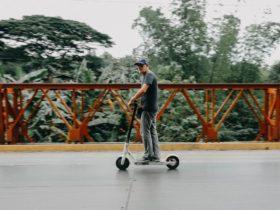source : news.mit.edu – William Litant | Department of Aeronautics and Astronautics
Electric shuttles will whisk volunteers about campus while gathering data for on-demand transportation services.
Starting this month, there’s a new way for some of the MIT community to make its way around the Institute: chauffeured golf cart. Three of the diminutive, four-passenger electrical vehicles will ply the byways of West Campus, summoned, Uber-like, via a smartphone app, then plucking up passengers and depositing them at locations of their choice within a select service area.
The mobility-on-demand service is part of a collaboration between the MIT Aeronautics and Astronautics Department’s Aerospace Controls Lab (ACL) and Ford Motor Company to develop a means of predicting customer location and requests for demand transportation services, while demonstrating algorithms and methods for navigating densely crowded pedestrian areas.
“Through the mobility-on-demand system we’re developing, we can investigate new planning and prediction algorithms in a complex, but controlled, environment, while simultaneously providing a testbed framework for researchers and a service to the MIT community,” says ACL director Jonathan How, who is also the Richard Cockburn Maclaurin Professor in Aeronautics and Astronautics. ACL researches topics related to autonomous systems and control design for aircraft, spacecraft, and ground vehicles. Theoretical and experimental research is pursued in such areas as estimation and navigation, planning and learning under uncertainty, and vehicle autonomy.
Since early this year the vehicles have plied campus byways, capturing pedestrian flow via onboard LIDAR and cameras, accumulating data to help the service anticipate where the most demand for the shuttles will be at any given moment.
The LiDAR scans pinpoint the vehicles’ locations and detect the movement of nearby pedestrians, allowing researchers to log the typical movements of people across the campus each day. Accurately predicting demand based on pedestrian flows will allow the shuttles to be carefully pre-positioned and routed to serve the MIT population in the most efficient way possible. “It’s all about being in the right place at the right time,” How says.
Researchers also take other factors into account that affect the movement of pedestrians on MIT’s campus, such as varying weather conditions, class schedules, and the dynamic habits of the MIT community across different semesters.
MIT community members who have volunteered for the test will use a smartphone app to indicate where they want to be picked up and dropped off. In return, they’ll be given a pickup time estimate. If things go as anticipated, they won’t be waiting long for a ride to arrive.
The vehicles are small enough to navigate sidewalks, while leaving plenty of room for pedestrian traffic. They’re outfitted with weatherproof enclosures to shield riders from inclement weather, which will be an especially rewarding feature when fall arrives.
How says that the local ride-hailing concept may someday provide a service that fills gaps between shuttle buses, automobiles, and public transportation, and may also have application to development of fully autonomous vehicles.
How says that the mobility-on-demand service will continue throughout the winter “unless Cambridge gets hit with blizzards like those we got a couple of years ago.”
“Through the mobility-on-demand system we’re developing, we can investigate new planning and prediction algorithms in a complex, but controlled, environment, while simultaneously providing a testbed framework for researchers and a service to the MIT community,” says ACL director Jonathan How, who is also the Richard Cockburn Maclaurin Professor in Aeronautics and Astronautics. ACL researches topics related to autonomous systems and control design for aircraft, spacecraft, and ground vehicles. Theoretical and experimental research is pursued in such areas as estimation and navigation, planning and learning under uncertainty, and vehicle autonomy.
Since early this year the vehicles have plied campus byways, capturing pedestrian flow via onboard LIDAR and cameras, accumulating data to help the service anticipate where the most demand for the shuttles will be at any given moment.
The LiDAR scans pinpoint the vehicles’ locations and detect the movement of nearby pedestrians, allowing researchers to log the typical movements of people across the campus each day. Accurately predicting demand based on pedestrian flows will allow the shuttles to be carefully pre-positioned and routed to serve the MIT population in the most efficient way possible. “It’s all about being in the right place at the right time,” How says.
Researchers also take other factors into account that affect the movement of pedestrians on MIT’s campus, such as varying weather conditions, class schedules, and the dynamic habits of the MIT community across different semesters.
MIT community members who have volunteered for the test will use a smartphone app to indicate where they want to be picked up and dropped off. In return, they’ll be given a pickup time estimate. If things go as anticipated, they won’t be waiting long for a ride to arrive.
The vehicles are small enough to navigate sidewalks, while leaving plenty of room for pedestrian traffic. They’re outfitted with weatherproof enclosures to shield riders from inclement weather, which will be an especially rewarding feature when fall arrives.
How says that the local ride-hailing concept may someday provide a service that fills gaps between shuttle buses, automobiles, and public transportation, and may also have application to development of fully autonomous vehicles.
How says that the mobility-on-demand service will continue throughout the winter “unless Cambridge gets hit with blizzards like those we got a couple of years ago.”















